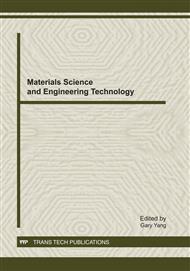[1]
D.C. Look, D.C. Reynolds, C.W. Litton, R.L. Jones, D.B. Eason and G. Cantwell, Characterization of homoepitaxial p-type ZnO grown by molecular beam epitaxy, Appl Phys Lett 10 (2002) 1830-1832.
DOI: 10.1063/1.1504875
Google Scholar
[2]
M.H. Huang, S. Mao, H. Feick, H.Q. Yan, Y.Y. Wu, H. Kind, E. Weber, R. Russo and P.D. Yang, Room-temperature ultraviolet nanowire nanolasers, Science 5523 (2001) 1897-1899.
DOI: 10.1126/science.1060367
Google Scholar
[3]
C.C. Chang and Y.E. Chen, Fabrication of high sensitivity ZnO thin film ultrasonic devices by electrochemical etch techniques, Ieee T Ultrason Ferr 3 (1997) 624-628.
DOI: 10.1109/58.658315
Google Scholar
[4]
E. Bonnotte, C. Gorecki, H. Toshiyoshi, H. Kawakatsu, H. Fujita, K. Worhoff and K. Hashimoto, Guided-wave acoustooptic interaction with phase modulation in a ZnO thin-film transducer on an Si-based integrated Mach-Zehnder interferometer, J Lightwave Technol 1 (1999).
DOI: 10.1109/50.737419
Google Scholar
[5]
Y.N. Xia, P.D. Yang, Y.G. Sun, Y.Y. Wu, B. Mayers, B. Gates, Y.D. Yin, F. Kim and Y.Q. Yan, One-dimensional nanostructures: Synthesis, characterization, and applications, Adv Mater 5 (2003) 353-389.
DOI: 10.1002/adma.200390087
Google Scholar
[6]
K. Matsubara, P. Fons, K. Iwata, A. Yamada, K. Sakurai, H. Tampo and S. Niki, ZnO transparent conducting films deposited by pulsed laser deposition for solar cell applications, Thin Solid Films (2003) 369-372.
DOI: 10.1016/s0040-6090(03)00243-8
Google Scholar
[7]
K.J. Chen, F.Y. Hung, S.J. Chang and Z.S. Hu, Microstructures, optical and electrical properties of In-doped ZnO thin films prepared by sol-gel method, Appl Surf Sci 12 (2009) 6308-6312.
DOI: 10.1016/j.apsusc.2009.02.007
Google Scholar
[8]
D. Kohl, Function and applications of gas sensors, J Phys D Appl Phys 19 (2001) R125-R149.
DOI: 10.1088/0022-3727/34/19/201
Google Scholar
[9]
N. Barsan, M. Schweizer-Berberich and W. Gopel, Fundamental and practical aspects in the design of nanoscaled SnO2 gas sensors: a status report, FRESENIUS JOURNAL OF ANALYTICAL CHEMISTRY 4 (1999) 287-304.
DOI: 10.1007/s002160051490
Google Scholar
[10]
N. Barsan and U. Weimar, Conduction model of metal oxide gas sensors, J Electroceram 3 (2001) 143-167.
Google Scholar
[11]
N. Barsan and U. Weimar, Understanding the fundamental principles of metal oxide based gas sensors; the example of CO sensing with SnO2 sensors in the presence of humidity, J Phys-Condens Mat 20 (2003) R813-R839.
DOI: 10.1088/0953-8984/15/20/201
Google Scholar
[12]
Z.J. Zou, Y. Liu, H.Y. Li, Y.C. Liao and C.S. Xie, Synthesis of TiO2/WO3/MnO2 Composites and High-Throughput Screening for Their Photoelectrical Properties, J Comb Chem 3 (2010) 363-369.
DOI: 10.1021/cc1000117
Google Scholar
[13]
Y. Muraoka, N. Takubo and Z. Hiroi, Photoinduced conductivity in tin dioxide thin films, J Appl Phys 10370210 (2009).
Google Scholar
[14]
A. Banerjee, A.K. Haldar, J. Mondal, A. Sen and H.S. Maiti, Bi-layer functionally gradient thick film semiconducting methane sensors, B Mater Sci 6 (2002) 497-499.
DOI: 10.1007/bf02710536
Google Scholar
[15]
A. Varpula, S. Novikov, J. Sinkkonen and M. Utriainen, Bias dependent sensitivity in metal-oxide gas sensors, Sensor Actuat B-Chem 1Sp. Iss. SI (2008) 134-142.
DOI: 10.1016/j.snb.2007.12.013
Google Scholar
[16]
J. Nelson, A.M. Eppler and I.M. Ballard, Photoconductivity and charge trapping in porous nanocrystalline titanium dioxide, J Photoch Photobio A 1-3Sp. Iss. SI (2002) 25-31.
DOI: 10.1016/s1010-6030(02)00035-7
Google Scholar
[17]
J. Suehiro, N. Nakagawa, S. Hidaka, M. Ueda, K. Imasaka, M. Higashihata, T. Okada and M. Hara, Dielectrophoretic fabrication and characterization of a ZnO nanowire-based UV photosensor, Nanotechnology 10 (2006) 2567-2573.
DOI: 10.1088/0957-4484/17/10/021
Google Scholar


